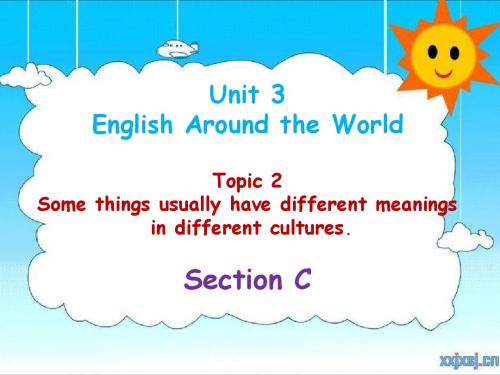九年级英语上册 Unit 3 Topic 2 Section C教案
- 格式:doc
- 大小:75.50 KB
- 文档页数:4


Unit 2 Saving the EarthTopic 2 All these problems are very serious.SectionCThe main activity is 1a. 本课重点活动是1a。
Ⅰ. Teaching aims and demands 教学目标1. Learn some new words and phrases:on earth, period, millions of, take away, rise, level, refer to2. Learn some useful sentences:(1) When it rains or when the wind blows, the earth is taken away.(2) The heat from the sun can’t escape so the temperature is rising.3. Learn to talk about the harm of pollution:(1) Forests have become deserts, so more and more sorts of animals and plants are disappearing.(2) As a result, many rivers and lakes are now dead.(3) Too much harmful radiation from the sun passes through the hole and reaches the earth directly.(4) It causes the level of the oceans to rise and the climate of the earth to change.4. Develop the students’ sense of environmental protection.Ⅱ. Teaching aids 教具图片/小黑板Ⅲ. Five-finger Teaching Plan 五指教学方案Step 1 Review 第一步复习(时间:4分钟)通过检查作业,引导学生开拓思维,提出保护环境和水资源的具体措施,复习不定代词和副词。




九年级上册Unit 3 Topic 1 English is widely spoken throughout the world.Section C【教学构思】一、教材分析:本课属于课标话题人与社会——“语言学习(Language learning)”中语言与文化(Language and culture)项目,主要谈论英语这门语言的普及程度和重要地位。
主要教学活动为1a,2,3a和3a,通过阅读1a语篇了解英语这门语言的普及程度和重要地位,通过多种形式的阅读活动培养基本的阅读技能,如略读、寻找主旨句、寻读等,提高学生“读”的语言能力。
阅读2语篇,用所给单词补全短文,进一步培养学生快速获取信息的能力。
3a学生通过小组讨论以及查询信息的方式,探讨解决3a中提出的问题,并在3a 讨论的基础上,写出一篇短文,提高学生“写”的语言能力。
二、设计说明:根据学情和本课的语法及话题,本节课的教学设计将读与写相结合,以1a阅读篇章为载体,立足话题,聚焦语法,培养学生“读”和“说”的语言能力;在语言生成阶段,循序渐进,从小组讨论到短文写作,进一步培养学生“说”和“写”的语言能力,鼓励学生讨论思考,培养他们的思维品质。
本课在重、难点突破的方法上有所创新,教师通过组织学生小组讨论问题,引导学生学会搜索信息,分析、讨论、概括、总结,在读和说的基础上进行写作,既提高学生的语言能力,又培养学生思维品质。
【教学目标】1. 能够根据不同的阅读目的运用阅读策略获取信息,培养“读”的语言能力;2. 通过阅读语篇,巩固一般现在时被动语态的用法,理解语篇能从上下文找到数字指代的事物;3. 通过小组讨论,搜集准备写作素材,培养“说”和“写”的语言能力;4. 在语篇中了解英语的普及程度和重要性,认识到学习英语的重要性,提高学习英语的意识。
【教学重难点】1. 正确使用被动语态;2. 独立起草作文。
【教学方法】任务型教学法【教具】多媒体设备,教学课件【教学过程】Step 1. GreetingStep 2. Review1. Review the passive voice by doing some exercises.2. Review the dialogue in Section B by answering the teacher’s questions.(设计意图:在练习中巩固被动语态,通过师生对话中复习Section B所学,巩固学生所学知识,导入本课话题,激发学生学习兴趣。
Unit 2 Saving the EarthTopic 3 What can we do at home to protect the environment?Section C教学设计一、教学目标1. 掌握本课重点词汇:technology, wheel, guide, steel, sunlight, steam, nuclear, renewable, disadvantage, process, require, electric, best-known, path, deep, source, worldwide2. 掌握本课重点句型:To solve the problem, people all over the world are looking for new ways to produce power.It’s key disadvantage is that the process requires a long time (up to 30 days) and the high cost for its building.3. 能够读懂有关新能源的开发和利用的文章,并获取信息。
4. 树立环保节能的观点,了解新能源的种类与发展。
二、教学重点及难点重点:1. 掌握本课重点词汇和句型。
2. 能够读懂有关新能源的开发和利用的文章,并获取信息。
难点:帮助学生树立环保节能的观点,了解新能源的种类与发展。
三、教学过程Step 1 Warming-upGuide Ss to talk about what they often do to be a greener person.【设计意图】引导学生讨论在日常生活中如何环保节能,帮助学生树立环保节能的观点。
Step 2 Pre-readingGuide Ss to look at the pictures and learn the new energy resources.【设计意图】通过展示图片,帮助学生了解新能源的种类,引入本课话题。
Unit 3. Topic 2. Section ATeaching aims and demands:1.Learn the usage of showing the future by the present continuous tense .2. Know about the differences in speaking English among different Englishspeaking countriesTeaching key points:1.Key phrases2.The usage of showing the future by the present continuous tense. Teaching difficult points:The usage of showing the future by the present continuous tense. Teaching procedure:Step 1. Preview:1.Read the new words following the tape.2.Read 1a quickly, then finish 1b and 1c. Check the answers.3.Read 1a carefully, find out the key points.Step 2. Discussion1.Discuss the following phrases:1>. notice sb. do / doing sth.Notice + that clause2>. Help sb. do sth. / help sb. with sth.3>. calm v. 使平静adj. 平静的,沉着的(心情不激动)calm downquiet adj. 安静的,宁静的(指没有声音,不吵闹)silent adj. 寂静的,沉默的,不发音的(指不说话)4>. keep a secret./ It’s a secret.5>. have a victory.2 . Discuss 1a in groupsStep 3. Explain some difficult language points to students. Then finish 2a.Check the answers.Step 4. Do exercises(见课件)Finish 3. Check the answers.Step 5. Sum up this lesson, show homework.Written on the blackboard:Section A一. key phrases二. grammar课后反思:。